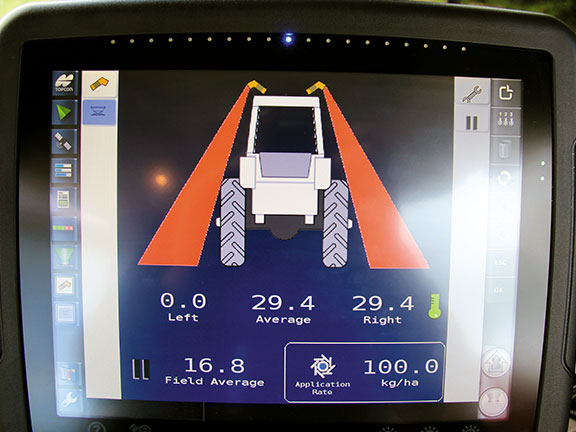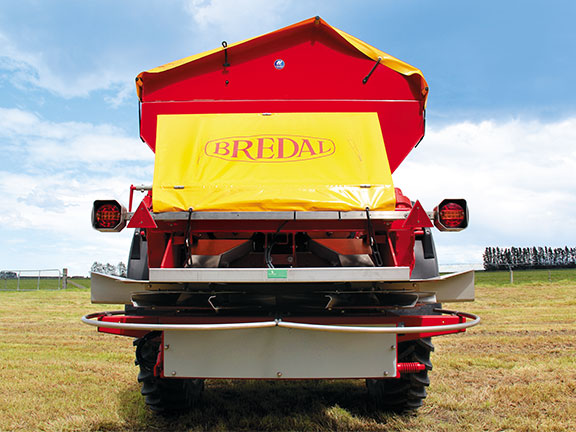Jaiden Drought was excited to test a Bredal F8 fertiliser spreader, kitted out with a Topcon X30 GPS system and crop spec sensors for real-time nitrogen reporting. And he wasn’t disappointed
Despite being part of a generation that has grown up with technology as part of farm machinery, I am still staggered by the amount of useable information available from today’s technology packages – particularly when I discover technology that not only increases the efficiency of a machine but also of a whole operation.
A recent trip to Canterbury, New Zealand, allowed me to spend a day checking out the Bredal F8 precision fertiliser spreader, kitted out with Topcon’s X30 GPS system and nitrogen sensors.
The machine is being used by farm manager Mark McCully, who is responsible for more than 1000 hectares of arable land. He is passionate about utilising this level of technology to take advantage of the yield potential of each paddock on the farm.
This is achieved with tramlines, starting with 8m cultivation and planting through to 30m spreading and spraying, all full Real-Time Kinematic (RTK) GPS, with about 2.5cm accuracy.
Combined with yield mapping and full-paddock nitrogen reports, this gives a massive amount of information to ensure the best return on investment from the land.
Mark’s knowledge on how to make the most of the information he is provided with is also impressive. You can have all the information and technology in the world, but unless you have people who know how to decipher the relevant data, it is wasted money.
 |
|
The ISOBUS display
|
Hopper
This trailed spreader from Bredal – a Danish company that has been producing high-quality agricultural spreaders for more than 50 years – will give you highly accurate spreading from a large 5700-litre capacity bin.
This bin sits on a four-piece (10 tonne) weigh cell incorporated chassis with an integrated tilt sensor.
The nifty feature here is the ability to perform real-time weighing even on hilly terrain. Either up or down hills or along the side, if you are game enough, these sensors will ensure the correct amount is being dosed out both the left- and right-side belts.
Spreading
This is where all the tricks come out of the Bredal hat. Each side of the spreader uses a separate belt to deliver the correct amount of fertiliser whether it is on a field border (using the border control), a triangle (using the section control), or simply turning a corner.
The door height adjustment is made in 20mm increments and, as long as the ISOBUS controller knows this, it uses the belt speed (either faster or slower) to deliver the correct dose.
The rear of the machine is mostly stainless or plastic. It is ideal, given the corrosive nature of the job.
Once it comes out of the belt, the material is sent down the electronically controlled chutes which drop the product at the exact point on the disc.
The chute is operated by electric actuators via the ISOBUS controller. Once the spreading width is chosen, the chutes are adjusted automatically as well as individually on both the right and left sides. The same applies to headland spreading.
Built into the chutes software is automatic flow correction, which self-adjusts to the current output amount. This is particularly handy with the variable rate used in conjunction with the real-time nitrogen sensors, which I will explain later.
Back from software to hardware – the drive to the spreading discs is PTO to two V-belts at the rear under the spinners. This is specced as such because it is ideally suited for 24m-36m spread widths.
Also fitted to our test machine were the optional H-discs for spreading fertiliser types such as urea, potash, and ammonium sulphate with widths of more than 24m.
 |
|
The real-time N readings on the ISOBUS display
|
Accuracy
I guess it is easy to take things as gospel these days, as clever marketing boffins will have you believe from their flashy brochures that anything is possible and their machine could work effortlessly on the moon.
However, back here on earth, all Bredal spreaders are regularly tested over a wide range of fertiliser types at the independent spreader test facility at Bygholm (part of Aarhus University) in Denmark.
Some spreaders get their spreading data from computer modelling and, given the spec level of these Bredal machines, you could be tricked into thinking this is also the case.
However, Bredal believes in the practical infield method of testing by accurately weighing the actual quantity collected in each tray. This is something Mark also does with the supplied Bredal calibration kit which consists of seven test trays, seven separators, seven measuring tubes, a granule strength tester, a funnel, and a sieve box to check the granule sizes.
Other features
- Spring-loaded tightening of belts provides for their correct fixing way
- The spreader is as standard with wide-angle PTO
- BPW axle is a powerful 10-tonner equipped with hydraulic brakes
- Manual roll-top cover, although hydraulic option is available
- Clearance under the spreader and discs is 1m
- The entire machine is either heat treated with a two-pack paint or in high-corrosion areas; stainless or plastic for long service life
 |
|
Front view of the twin-belt floor
|
Controller
The spreader controller on our test machine was run through ISOBUS with additional CropSpec sensors to a Topcon X30 display.
This X30, 12.1-inch full colour touchscreen is an impressive setup with drag-and-drop info windows. The user-definable dashboard can simultaneously display five different functions on-screen and in real time.
The large colour touchscreen is easy to navigate as the picture icons allow you to drag up or close down particular screens. For those running a number of different machines on each tractor, the X30 can run real-time variable-rate control for up to eight products and up to 30-section auto section controller for sprayers, planters or spreaders such as this Bredal F8.
CropSpec N sensors
CropSpec consists of two sensor units mounted on top of the cab. Using infrared beams that work on the red-edge scale, these measure plant reflection to determine chlorophyll content, which is closely related to the nitrogen concentration in the leaf.
In essence, there are three modes in which you can use that data available from the sensors:
Read and record
Exactly as the name suggests, you record data from scanning the crop, which creates a map indicating nitrogen levels. This will show nitrogen-rich and deficient areas. This info can then be used to create a variable-rate application.
User-determined rate
This allows you to set high and low points and then perform the application using field averaging. The target rate can be set by the operator to, say, 200kg/ha top and 100kg/ha bottom, meaning the field average will be 150kg/ha.
Real-time variable-rate application
Again, as the name suggests, when using the Topcon CropSpec and VRC software together (which our test machine had), the driver can set the machine to a variable-rate spread as the nitrogen levels are determined in real time. This is the ideal one-pass solution.
I was impressed by the nitrogen sensors. With the variable-rate and section-control capabilities of the spreader, if the average over the paddock needs to be 150kg/ha, the poorer-performing parts will get 200kg/ha and the more fertile parts will get 100kg/ha.
This is all done in real time via the CropSpec sensors. Yield mapping in the combines has shown this is a simple way of increasing total paddock yield – all from exactly the same amount of fertiliser as conventional spreading techniques.
 |
|
The bin has sightscreens for those who like to double-check the scales
|
The bottom line
Fertiliser can be hit and miss. Often in one load the granules are too soft and break into powder, while in the next load the granules stay complete until they hit the ground.
Over a 30m spreading width, this inconsistent product has a massive variation on spread pattern and also requires continuous calibration.
This highlights the importance of quality machinery and technology, such as the combination of the Bredal F8 precision spreader and Topcon’s X30 GPS system, to ensure you get every ounce of accuracy possible, and that is money well spent.
HITS
Excellent build quality
The combination of both high-speed accuracy and large hopper capacity
A combination of materials around the rear is ideal for longevity
A range of tyre options – the test machine was on row crops for tramlines
The level of technology was impressive given the yield gain potential
Well-thought-out machine, even a substantial holder for the hoses when shedded
Electronically controlled fert chutes give exact fert placement on the spreading disc
Twin-belt drive
Capable of spreading up to 36m with the H spreading discs
More than one metre of ground clearance
MISSES
The distribution chutes cannot handle the volume of high-application rates of products such as lime where it tends to shelve
 |
|
A large amount of stainless steel is used at the business end of the spreader to combat corrosion
|
SPECS
Bredal F8 fertiliser spreader
Capacity: 5.70m3
Capacity with hopper extension: 7,50m3
Net weight: 2800kg
Total length: 6.6m
Std. spreading unit: SPC4500-2
Hopper length: 3.92m
Hopper width: 2m
Loading height min: 2.5m
Loading height max: 3m
Min. width outside of wheels: 2.25m
Max. width outside of wheels: 2.8m








